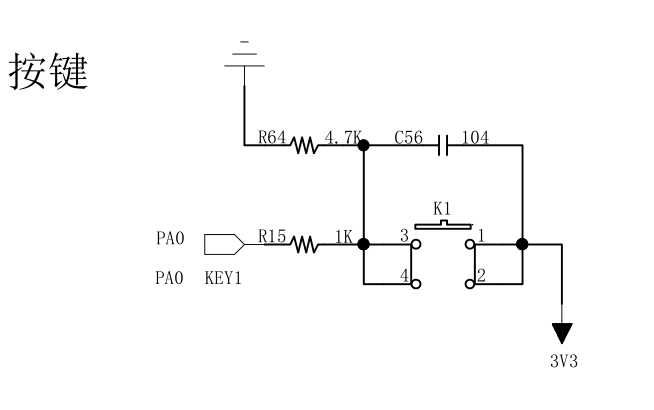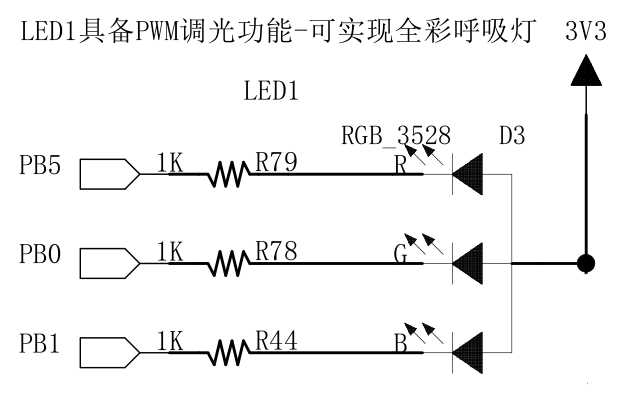标签:data dem 地址 条件编译 scan src 单片机 配置 bit
本例程基于先前的库函数版demo工程模板,主要内容为:bsp_led.h、bsp_led.c、bsp_key.h、bsp_key.c、main.c
1、bsp_led.h
1 #ifndef __BSP_LED_H //条件编译,如果没有定义这个宏,向下执行;如果已经定义则不向下执行,结束条件编译。 2 #define __BSP_LED_H //没有定义,则定义该宏。 当下次该头文件被编译时,该宏已经编译,即直接结束条件编译。 3 4 #include "stm32f10x.h" //下面用到外设的寄存器映射 5 //绿色led宏定义一下,便于移植 6 #define LED_G_GPIO_PIN GPIO_Pin_0 7 #define LED_G_GPIO_PORT GPIOB 8 #define LED_G_GPIO_CLK RCC_APB2Periph_GPIOB 9 10 11 #define ON 1 12 #define OFF 0 13 14 // \ 续行符,后面不能有任何东西 15 16 #define LED_G(a) if(a) 17 GPIO_ResetBits(LED_G_GPIO_PORT, LED_G_GPIO_PIN); \ //复位,PB0的ODR寄存器对应位置0 18 else GPIO_SetBits(LED_G_GPIO_PORT, LED_G_GPIO_PIN); //PB0的ODR寄存器对应位置1 19 20 // ^ 异或 21 22 #define LED_G_TOGGLE {LED_G_GPIO_PORT->ODR ^= LED_G_GPIO_PIN;} //端口设置寄存器BSRR对应位为1,ODR寄存器对应位反复与BSRR取异或,实现0变1,1变0 23 24 void LED_GPIO_Config(void); //在头文件中定义bsp_led.c中的函数,目的是便于其他c文件调用。 25 26 #endif /* __BSP_LED_H */ //结束条件编译
2、bsp_led.c
1 #include "bsp_led.h" 2 3 void LED_GPIO_Config(void) 4 { 5 GPIO_InitTypeDef GPIO_InitStruct;//定义GPIO结构体 6 7 RCC_APB2PeriphClockCmd(LED_G_GPIO_CLK, ENABLE);//使能APB2总线时钟 8 9 GPIO_InitStruct.GPIO_Pin = LED_G_GPIO_PIN;//0号引脚 10 GPIO_InitStruct.GPIO_Mode = GPIO_Mode_Out_PP;//推挽输出 11 GPIO_InitStruct.GPIO_Speed = GPIO_Speed_50MHz;//输出频率50MHz 12 13 GPIO_Init(LED_G_GPIO_PORT, &GPIO_InitStruct);//GPIO初始化函数,入口参数1为GPIOB,入口参数2为GPIO结构体首地址,因此&取地址 14 }
3、bsp_key.h
1 #ifndef __BSP_KEY_H 2 #define __BSP_KEY_H 3 4 #include "stm32f10x.h" 5 6 #define KEY_ON 1 7 #define KEY_OFF 0 8 9 #define KEY1_GPIO_PIN GPIO_Pin_0 10 #define KEY1_GPIO_PORT GPIOA 11 #define KEY1_GPIO_CLK RCC_APB2Periph_GPIOA 12 13 void KEY_GPIO_Config(void); 14 uint8_t Key_Scan(GPIO_TypeDef *GPIOx,uint16_t GPIO_Pin); 15 16 #endif /* __BSP_KEY_H */ 17 18 //该头文件与bsp_led.h结构完全一致,不做说明。
4、bsp_key.c
1 #include "bsp_key.h" 2 3 4 void KEY_GPIO_Config(void) 5 { 6 GPIO_InitTypeDef GPIO_InitStruct; 7 8 RCC_APB2PeriphClockCmd(KEY1_GPIO_CLK, ENABLE); 9 10 GPIO_InitStruct.GPIO_Pin = KEY1_GPIO_PIN; 11 GPIO_InitStruct.GPIO_Mode = GPIO_Mode_IN_FLOATING; 12 13 GPIO_Init(KEY1_GPIO_PORT, &GPIO_InitStruct); 14 } 15 //以上重复部分不做说明。 16 uint8_t Key_Scan(GPIO_TypeDef *GPIOx,uint16_t GPIO_Pin)
//此为自定义按键扫描函数,入口参数定义来自于标准函数GPIO_ReadInputDataBit(GPIOx,GPIO_Pin)入口参数,读取的是IDR寄存器对应位 17 { 18 if( GPIO_ReadInputDataBit(GPIOx, GPIO_Pin) == KEY_ON ) //key1按下,PA0输入高电平,GPIO_ReadInputDataBit()读1 19 { 20 // 松手检测 21 while( GPIO_ReadInputDataBit(GPIOx, GPIO_Pin) == KEY_ON ); //key1按下后未断开,执行该死循环,执行语句为空; 22 return KEY_ON; //按键断开后,返回1 23 } 24 else return KEY_OFF; //没有检测到key1按下返回0 25 }
5、main.c


1 #include "stm32f10x.h" // 相当于51单片机中的 #include <reg51.h> 2 #include "bsp_key.h" 3 #include "bsp_led.h" 4 void Delay( uint32_t count )//软件延时,未用 5 { 6 for(; count!=0; count--); 7 } 8 9 int main(void) 10 { 11 // 来到这里的时候,系统时钟已经被配置成72M 12 LED_GPIO_Config(); 13 KEY_GPIO_Config(); 14 15 while(1) 16 { 17 if( Key_Scan(KEY1_GPIO_PORT,KEY1_GPIO_PIN) ==KEY_ON ) 18 LED_G_TOGGLE; 19 20 // 每按下key1一次,执行一次LED反转 21 } 22 }
7
标签:data dem 地址 条件编译 scan src 单片机 配置 bit
原文地址:https://www.cnblogs.com/wuguangzong/p/10881170.html